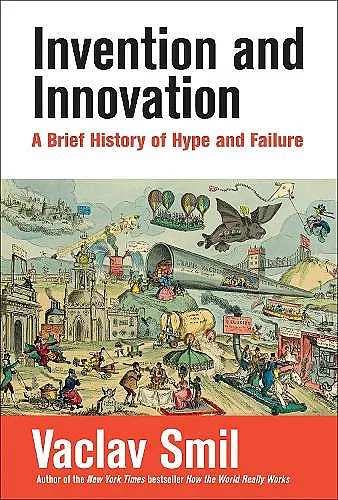Invention and Innovation
A Brief History of Hype and Failure
Format:Hardback
Publisher:MIT Press Ltd
Published:7th Feb '23
Currently unavailable, our supplier has not provided us a restock date

Tour the history of human invention—and its attendant breakthroughs and busts—in this history book from the New York Times-bestselling author of How the World Really Works.
A BILL GATES RECOMMENDED BOOK: “Every Smil book that I own is marked up with lots of notes that I take while reading. Invention and Innovation is no exception.”
The world is never finished catching up with Vaclav Smil, author of New York Times bestsellers How the World Really Works and Energy and Civilization. In Invention and Innovation, the prolific author—a favorite of Bill Gates—pens an insightful and fact-filled jaunt through the history of human invention. Impatient with the hype that so often accompanies innovation, Smil offers in this book a clear-eyed corrective to the overpromises that accompany everything from new cures for diseases to AI. He reminds us that even after we go quite far along the invention-development-application trajectory, we may never get anything real to deploy. Or worse, even after we have succeeded by introducing an invention, its future may be marked by underperformance, disappointment, demise, or outright harm.
Drawing on his vast breadth of scientific and historical knowledge, Smil explains the difference between invention and innovation, and looks not only at inventions that failed to dominate as promised (such as the airship, nuclear fission, and supersonic flight), but also at those that turned disastrous (leaded gasoline, DDT, and chlorofluorocarbons). And finally, most importantly, he offers a “wish list” of inventions that we most urgently need to confront the staggering challenges of the twenty-first century.
Filled with engaging examples and pragmatic approaches, this book is a sobering account of the folly that so often attends human ingenuity—and how we can, and must, better align our expectations with reality.
Included in BILL GATES's 2023 Holiday Reading List
Included in Lit Hub’s Most Anticipated Books of 2023
Included in The Next Big Idea Club’s February 2023 Must-Read Books
"Every Smil book that I own is marked up with lots of notes that I take while reading. Invention and Innovation is no exception. Even when I disagree with him, I learn a lot from him...he always strengthens my thinking."
—Bill Gates, Gates Notes
"In what is essentially a history of invention (and therefore, in many ways, a history of civilization) Smil reminds us that human beings tend to fail a lot more than they succeed. And yet we are forever striving after better ways to do things, straining toward some perfectible society that no single generation will ever reach. Though Smil warns against our seemingly innate compulsion to overpromise, he also celebrates our capacity for collective innovation, and recognizes we’re going to need a lot of good ideas to get us out of the 21st century."
—Lit Hub
"Smil, the author of more than 40 books on scientific subjects and global matters, is always worth reading...An informative, entertaining package from a gifted, original thinker."
—Kirkus Reviews
"Smil (How the World Really Works), a professor emeritus at the University of Manitoba, takes a thought-provoking look at what “the long trajectory of inventions” suggests about what to expect in the future...This is a solid corrective to the notion that human inventiveness can tackle any challenge."
—Publishers Weekly
"While general usage tends to regard the terms invention and innovation as interchangeable synonyms, the eagle-eyed engineer will already be aware of the subtle but important difference between the two. While invention is focused on coming up with the ideas and discoveries in the first place, as Vaclav Smil says in his latest in a long line of highly readable analyses of the modern world."
—E&T, Engineering & Technology
"As an environmentalist and energy writer, Vaclav Smil is well placed to analyse the impact of past and promised inventions and innovations. He distinguishes between these concepts: innovation, he says, involves “mastering new materials, products, processes and ideas”. He focuses engagingly on three types of “failed” invention: welcomed but then unwelcome (for example, leaded petrol and the pesticide DDT); over-hyped (such as nuclear fission and supersonic flight); and undelivered (including travel by vacuum tube and controlled nuclear fusion)."
—Nature
"The prolific Smil (emer., Univ. of Manitoba), whose 40 published titles include Energy and Civilization and Global Catastrophes and Trends, examines the history of innovation failure since the 1860s. Briefly distinguishing between invention and innovation (an outcome), he sorts the latter into three categories: those that failed to dominate, those that were disastrous, and those still promised but yet to appear. Topical examples include fuel additives, nuclear energy, supersonic flight, hyperloop (vacuum tube) transport, and nitrogen-fixing cereals... Smil deftly supports his arguments with rich details and sobering statistics, calling for the need to improve the life of the world's population while avoiding impacts to the biosphere."
—CHOICE
"Smil, put a sharp focus on the hype cycle that drives so many tech innovations, like AI and biotech. For one example, he turns his lens on the often-promised microreactor revolution in nuclear power, scoffing that as of yet “no nation has announced any specific, detailed, and binding commitment to what would have to be a multidecadal program of reactor construction.” In other words as we’ve noted here in DFD, the future might be coming, but it’s often hard to build."
—Politico
ISBN: 9780262048057
Dimensions: unknown
Weight: unknown
208 pages